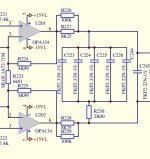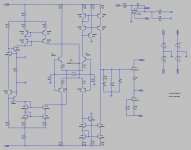RIAA makes it Non-Linear : Straight garbage in, Bent garbage out.
Feedback is intended to make something Linear, so only applicable to Linear gain stages, aka fixed gain.
Super-Symmetrical feedback is super-duper fast, but still feedback, so not output to input.
For example : regular opamps ? Bèèh !
Or OPA1632/THS4131 ? Mmmm ?
Or discrete UGS critters with SuSY ? (wink-wink, nodge-nodge)
Feedback is intended to make something Linear, so only applicable to Linear gain stages, aka fixed gain.
Super-Symmetrical feedback is super-duper fast, but still feedback, so not output to input.
For example : regular opamps ? Bèèh !
Or OPA1632/THS4131 ? Mmmm ?
Or discrete UGS critters with SuSY ? (wink-wink, nodge-nodge)
Attachments
Last edited:
Stefanoo, i am still missing the circuit that sounds so good. You said you posted it before so it is sufficient to lead me to that post.
Gonna post it now.
Had to give it more listening
as promised, here it is.
Sound is good. I would be curious to see if a different output stage would perform even better and if the BJT for the peaking of the CM will help linearity.
I don't see any oscillation problem with it though.
I haven't made distortion measurement nor spectrum/ residual noise yet.
At listening the phono sounds with good dark background and nice low level resolution.
This doesn't mean that improvements are not needed, but it starts off pretty good.
I will try to rig up the balance version in the next days.
I have a question:
if in SE mode I load the cartridge with 100ohm when go to balance the two resistor have to be now 200ohm each or still 100ohm as shown on the schematic?
Sound is good. I would be curious to see if a different output stage would perform even better and if the BJT for the peaking of the CM will help linearity.
I don't see any oscillation problem with it though.
I haven't made distortion measurement nor spectrum/ residual noise yet.
At listening the phono sounds with good dark background and nice low level resolution.
This doesn't mean that improvements are not needed, but it starts off pretty good.
I will try to rig up the balance version in the next days.
I have a question:
if in SE mode I load the cartridge with 100ohm when go to balance the two resistor have to be now 200ohm each or still 100ohm as shown on the schematic?
Attachments
I think this circuit is very good in principle and it has good tuning potential. I tried this input stage in separation and it sounded very good to me. Very musical but also dynamic and open. Why not give up on the balanced in - balanced out version of this ? It would safe us a lot of trouble.
When you use a phono stage like his with two inputs and you want to load the cartridge with 100 Ohm you need 200 Ohm resistors on both inputs.
We have still the OPA1632 variety with the super J-Fets if we want to make bal-in bal-out unproblematic.
When you use a phono stage like his with two inputs and you want to load the cartridge with 100 Ohm you need 200 Ohm resistors on both inputs.
We have still the OPA1632 variety with the super J-Fets if we want to make bal-in bal-out unproblematic.
Last edited:
I think this circuit is very good in principle and it has goo tuning potential. I tried this input stage in separation and it sounded very good to me. Very musical but also dynamic and open. Why not give up on the balanced in - balanced out version of this ? It would safe us a lot of trouble.
When you use a phono stage like his with two inputs and you want to load the cartridge with 100 Ohm you need 200 Ohm resistors on both inputs.
We have still the OPA1632 variety with the super J-Fets if we want to make bal-in bal-out unproblematic.
I am cool with what you are suggesting.
Ijust thought it would have been fun to carry over both approaches since I see a lot of interest on this circuit.
Anyway I agree with you that this input stage is very dinymic and opened.
I also find it very neutral, not on the warm side but neither smearing or harsh.
The peaking in the mirrors does not show up at the output because the RIAA is rolled of to zero by 10 MHz. It is so high up that i do not think that it is a real problem.
We can of cause try to make a better mirror and a better buffer. The Paradise already has an improved buffer. Even the Pardise buffer can be improved though at the expense of a bit complexity. I do not know if the Paradise buffer can be beaten subjectively but it can be done in such a way that it has a more robust current drive so can drive very low impedances.
We can of cause try to make a better mirror and a better buffer. The Paradise already has an improved buffer. Even the Pardise buffer can be improved though at the expense of a bit complexity. I do not know if the Paradise buffer can be beaten subjectively but it can be done in such a way that it has a more robust current drive so can drive very low impedances.
I agree, the input stgae has my blessing. I already told you that i prefered it in the end over the current conveaour variety. Yes, this inpüt has a neutral " not there " kind of sound. I think we found the holy grail for a balanced BJT input. I would not look further but optimize what we have. Simply grounding the right side at the bases we can also compare bal in to unbal in so this circuit alows us to find out if balanced brings a benfit.
I agree, the input stgae has my blessing. I already told you that i prefered it in the end over the current conveaour variety. Yes, this inpüt has a neutral " not there " kind of sound. I think we found the holy grail for a balanced BJT input. I would not look further but optimize what we have. Simply grounding the right side at the bases we can also compare bal in to unbal in so this circuit alows us to find out if balanced brings a benfit.
I personally think balance brings on improvements.
I can hear the darker background, more contrast and more dynamic.
Yes I agree with you with the description of the input stage and I would work things around that as I think it is the holy grail of the BJTs.
I have tried several and this is the first one that convinces me that BJTs have good potential for good and nice tone of colors.
Do we want to improve this one with the super buffer you had posted some time ago?
It seems to be pretty complex compared to the simple Jfet's.
Do you think it could bring on some sonical benefit?
I have a little PCB I made some time ago gor that circuit I have never tried.
LEt me know if you want me to compare the sound of the two output stages.
As far as current mirrors are concerned we could try to improve them if you would like to.
If you have any thought on that let me know.
Also, if you want to continue in parallel the OPA's approach I am on for it.
I just need to get the simulator up and running for that.
Last I left the circuit it did not work.
http://www.diyaudio.com/forums/analog-line-level/226099-preamp-buffers-simple-idea.html
Here you find advanced versions of the Paradise buffer explored by another talented german engineer Calvin.
Here you find advanced versions of the Paradise buffer explored by another talented german engineer Calvin.
I agree, the input stgae has my blessing. I already told you that i prefered it in the end over the current conveaour variety. Yes, this inpüt has a neutral " not there " kind of sound. I think we found the holy grail for a balanced BJT input. I would not look further but optimize what we have. Simply grounding the right side at the bases we can also compare bal in to unbal in so this circuit alows us to find out if balanced brings a benfit.
you meant to say ground the left side, right?
The positive is on the right side, so I am sure you meant to say to ground left side.

Yes, i think the Calvin buffers could add a bit of slamm to the sound.
I will build the OPA1632 version anyway. One of my layout gurus has already made an SMD PCB of the OPA part. I do not have your amazing Fets but some LSK369 from Linear Systems so i can try the principle.
What is also good with our balananced variety is that we can implement that into the Paradise so mission acomplished, at least in theory,
I will build the OPA1632 version anyway. One of my layout gurus has already made an SMD PCB of the OPA part. I do not have your amazing Fets but some LSK369 from Linear Systems so i can try the principle.
What is also good with our balananced variety is that we can implement that into the Paradise so mission acomplished, at least in theory,
No, ground the right side. That is the parallel symmetric version of the Pink Tringle Pip designed by my friend Dr. Paul Mills, now with Tannoy.
It may also work grounding the left side but that variety suffers from Miller multiplication so is slower.
yeah but then it would become an inverting stage, wouldn't it?
Yes, i think the Calvin buffers could add a bit of slamm to the sound.
I will build the OPA1632 version anyway. One of my layout gurus has already made an SMD PCB of the OPA part. I do not have your amazing Fets but some LSK369 from Linear Systems so i can try the principle.
What is also good with our balananced variety is that we can implement that into the Paradise so mission acomplished, at least in theory,
I can build it too if you want. I just need to nail the working circuit first.
Do you want to create a more detailed schemati I can try to throw on the simulator?
http://home.tele2.at/alohka/page3.gif
It is funny but it works.
In our case the circuit inverts then. the cure is to revers the caertridge wires.
I gave out all you have to know about the OPA1632 stage.
No, i will not detail that circuit to any higher degree.
It is funny but it works.
In our case the circuit inverts then. the cure is to revers the caertridge wires.
I gave out all you have to know about the OPA1632 stage.
No, i will not detail that circuit to any higher degree.
- Status
- This old topic is closed. If you want to reopen this topic, contact a moderator using the "Report Post" button.
- Home
- Source & Line
- Analogue Source
- Masterpiece



